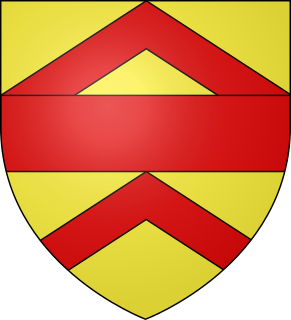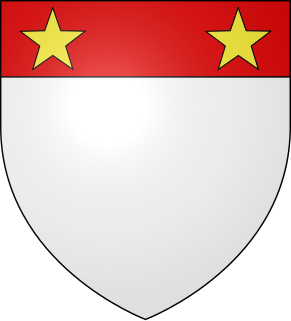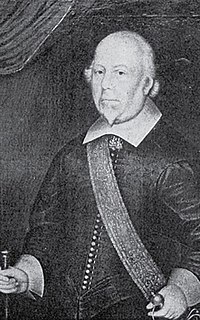Related Research Articles

Baron Audley is a title in the Peerage of England first created in 1313, by writ to the Parliament of England, for Sir Nicholas Audley of Heighley Castle, a member of the Anglo-Norman Audley family of Staffordshire.

Earl of Leicester is a title that has been created seven times. The first title was granted during the 12th century in the Peerage of England. The current title is in the Peerage of the United Kingdom and was created in 1837.

Baron FitzWalter is an ancient title in the Peerage of England. It was created on 24 June 1295 for Robert FitzWalter. The title was created by writ, which means that it can descend through both male and female lines. His great-grandson, the fourth Baron, was an Admiral of the Fleet. The fourth baron's grandson, the seventh Baron, was succeeded by his daughter and only child, Elizabeth. She was the wife of John Radcliffe. Their son, the ninth Baron, was attainted for treason in 1495 with his title forfeited. However, his son Robert Radcliffe obtained a reversal of the attainder by Act of Parliament in 1509 and later served as Lord Lieutenant of Lancashire. He was created Viscount FitzWalter in 1525 and Earl of Sussex in 1529. His grandson, the third Earl, was summoned to the House of Lords through a writ of acceleration in 1553 in his father's junior title of Baron FitzWalter. Lord Sussex later served as Lord Deputy of Ireland. He was succeeded by his younger brother, the fourth Earl. He had earlier represented Maldon, Hampshire and Portsmouth in the House of Commons and also served as Lord Lieutenant of Hampshire. When he died the titles passed to his only child, the fifth Earl. He was Lord Lieutenant of Essex.

Baron Willoughby de Eresby is a title in the Peerage of England. It was created in 1313 for Robert de Willoughby. Since 1983, the title has been held by Jane Heathcote-Drummond-Willoughby, 28th Baroness Willoughby de Eresby.

Baron Berners is a barony created by writ in the Peerage of England.
Baron Cromwell is a title that has been created several times in the Peerage of England. The first creation, which was by writ, was for John de Cromwell in 1308. On his death, the barony became extinct. The second creation came in 1375 when Ralph de Cromwell was summoned by writ to Parliament as Lord Cromwell. His grandson, the third baron, served as Lord High Treasurer to King Henry VI. However, on his death in 1455 the barony fell into abeyance between his nieces Maude and Joan. On Joan's death in 1490 the abeyance was terminated in favour of Maude, the fourth holder. When she died childless in 1497 the peerage once again fell into abeyance, this time between the daughters of the first baron. The title remained in abeyance for over 400 years. However, in 1922 the Committee for Privileges of the House of Lords reported in favour of the petition for the termination of the abeyancy of Selina Frances Bewicke-Copley. She was the daughter of Sir Charles Watson Copley, 3rd Baronet, and one of the co-heirs of Maud, daughter of the first baron Cromwell. Selina died in 1923 and in July of the same year the abeyance was terminated in favour of her son Robert Godfrey Wolesley Bewicke-Copley, who became the fifth baron. He notably served as Lord Lieutenant of Leicestershire. As of 2010 the ancient barony is held by his grandson, the seventh baron, who succeeded his father in 1982. Having lost his seat in the House of Lords under the House of Lords Act 1999, in April 2014 he was elected at a hereditary peers' by-election as a Crossbencher.

Baron Dacre is a title that has been created three times in the Peerage of England, every time by writ.

Baron Strange is a title that has been created several times in the Peerage of England. Two creations, one in 1295 and another in 1326, had only one holder each, upon the death of whom they became extinct. Two of the creations are extant. All four baronies of Strange have been created by writ, which means that they can pass through both male and female lines.
Baron Lisle was a title that was created five times in the Peerage of England during the Middle Ages and Tudor period. The earliest creation was for the family of Lisle of Rougemont, which bore arms: Or, a fess between two chevrons sable. The later creation of 1357 was for Lisle of Kingston Lisle, a younger branch of the Lisles of Rougemont. Robert de Lisle of Rougemont married Alice FitzGerold, the heiress of Kingston in the parish of Sparsholt, Berkshire. In 1269 Alice granted the manor of Kingston to her younger son Gerard I de Lisle, whose family adopted the arms of FitzGerold: Gules, a lion statant guardant argent crowned or. Gerard I's grandson was Gerard II de Lisle (1305–1360), created Baron Lisle in 1357.

Earl of Worcester is a title that has been created five times in the Peerage of England. The first creation came in 1138 in favour of the Norman noble Waleran de Beaumont. He was the son of Robert de Beaumont, 1st Earl of Leicester, by Elizabeth of Vermandois, and the twin brother of Robert de Beaumont, 2nd Earl of Leicester. Like his father and brother he also held the title Count of Meulan in the French nobility. The earldom of Worcester apparently became extinct on his death in 1166.

The title of Viscount Lisle has been created six times in the Peerage of England. The first creation, on 30 October 1451, was for John Talbot, 1st Baron Lisle. Upon the death of his son Thomas at the Battle of Nibley Green in 1470, the viscountcy became extinct and the barony abeyant.
The title of Baron Welles has been created thrice. It was first created for Adam de Welles on 6 May 1299 in the Peerage of England by writ of summons. This creation was extinguished by attainder in 1469. It was created a second time in the Peerage of England by writ of summons for Sir Richard Hastings on 15 November 1482 and became extinct on his death. The third creation was on 8 January 1781, in the Peerage of Ireland, for Thomas Knox, later Viscount Northland. It is now a subsidiary title of the Earl of Ranfurly.
The title Baron Bergavenny was created several times in the Peerage of England and once in the Peerage of Great Britain, all but the first being baronies created by error.

The titles Baron Montacute or Baron Montagu were created three and two times respectively in the Peerage of England for members of the Noble House of Montagu. The family name was Latinised to de Monte Acuto, meaning "from the sharp mountain"; the French form is an ancient spelling of mont aigu, with identical meaning.

Baron St John de/of Basing is a former title in the Peerage of England.
The title Baron Monthermer was created twice in the Peerage of England.
Baron Strange of Blackmere is an abeyant title in the Peerage of England. It was created on 13 January 1309 when Fulk le Strange was summoned to parliament. On the death of the fifth baron in 1375, it was inherited by Elizabeth Mowbray, nee le Strange. On her death in the year 1383, it was inherited by Ankaret Talbot, nee le Strange, daughter of the fourth Baron. On her son's death in 1419, the baron was inherited by Ankaret Talbot, his daughter. On her death in 1421, the barony was inherited by her uncle, John Talbot who was created Earl of Shrewsbury, Earl of Waterford and hereditary Lord High Steward of Ireland. On the death of the 7th earl in 1616, the barony fell into abeyance between his three daughters Mary, Elizabeth and Alethea. In 1651 Alethea became sole heir and therefore, Baroness Strange of Blackmere. The title continued in her descendants until the death of Edward Howard, 9th Duke of Norfolk and 22nd Baron Strange of Blackmere in 1777, when it again fell into abeyance. The co-heirs are the descendants of his nieces Winifred, Lady Stourton, and Ann, Lady Petre.
John (II) de Mowbray, 3rd Baron Mowbray was the only son of John de Mowbray, 2nd Baron Mowbray, by his first wife, Aline de Brewes, daughter of William de Braose, 2nd Baron Braose. He was born Hovingham, Yorkshire.

John Hussey, 1st Baron Hussey of Sleaford was Chief Butler of England from 1521 until his death. He was a member of the House of Lords, and a Chamberlain to King Henry VIII's daughter, Mary I of England.

The title Baron Cobham has been created numerous times in the Peerage of England; often multiple creations have been extant simultaneously, especially in the fourteenth century. The earliest creation was in 1313 for Henry de Cobham, lord of the manors of Cobham and of Cooling, both in the county of Kent. The eleventh baron was attainted in 1603, when the peerage became abeyant instead of becoming extinct. In 1916 the attainder was removed and the abeyance terminated in favor of the fifteenth baron. The twelfth to fourteenth barons never actually held the title. This creation became abeyant again in 1951.